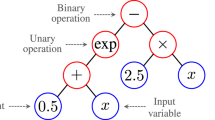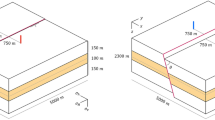Abstract
Pressure changes in the above zone, i.e., the overlying aquifer of an injection zone separated by a sealing caprock, are usually attributed to leakage through wells. However, pressure changes can be induced geomechanically due to rock deformation without any hydraulic connection between the injection zone and the above zone where the pressure change is observed. To account for these two causes of pressure change in the above zone, we develop an analytical solution to evaluate the deformation-induced pressure changes and we derive an asymptotic analytical solution for pressure perturbations caused by leaking wells. The analytical models compare well with available numerical/analytical solutions. Using the analytical solutions for the deformation- and leakage-induced pressure changes, we propose a graphical diagnostic plot to determine the cause of pressure change. Considering that the pressure change is caused by leakage, we then use the asymptotic solution to develop an easy-to-use fully graphical methodology to characterize leaking wells. This methodology improves a previous analysis methodology that was based on an inverse modeling algorithm that can be highly instable and computationally expensive. Based on the graphical method presented here, the slopes and intercepts of the proposed line-fitted graphs are used to determine the leak location and transmissibility. We apply the graphical method to an example problem to illustrate its application procedure and effectiveness in differentiating deformation-induced pressure changes from leaking wells. Overall, the diagnostic plot proposed here proves to be useful to determine the cause of the above-zone pressure change.








Similar content being viewed by others
References
Abramowitz M, Stegun IA (1970) Handbook of mathematical functions. Dover, New York
Avci CB (1994) Evaluation of flow leakage through abandoned wells and boreholes. Water Resour Res 30:2565–2578
Bear J (1972) Dynamics of Fluids in Porous Media. Elsevier, New York
Birkholzer JT, Zhou Q, Tsang C-F (2009) Large-scale impact of CO2 storage in deep saline aquifers: a sensitivity study on pressure response in stratified systems. Int J Greenh Gas Control 3:181–194
Bourdet D (2002) Well test analysis: the use of advanced interpretation models. Elsevier Science, Amsterdam
Carslaw HS, Jaeger JC (1959) Conduction of heat in solids, 2nd edn. Oxford Univ. Press, London
Chabora ER, Benson SM (2009) Brine displacement and leakage detection using pressure measurements in aquifers overlying CO2 storage reservoirs. Energy Procedia 1:2405–2412. doi:10.1016/j.egypro.2009.01.313
Chang KW, Hesse MA, Nicot J-P (2013) Reduction of lateral pressure propagation due to dissipation into ambient mudrocks during geological carbon dioxide storage. Water Resour Res. doi:10.1002/wrcr.20197
Cihan A, Zhou Q, Birkholzer JT (2011) Analytical solutions for pressure perturbation and fluid leakage through aquitards and wells in multilayered-aquifer systems. Water Resour Res 47:W10504. doi:10.1029/2011wr010721
Cooper H, Jacob C (1946) A generalized graphical method for evaluating formation constants and summarizing well field history. Am Geophys Union Trans 27:526–534
Gasda SE, Bachu S, Celia MA (2004) Spatial characterization of the location of potentially leaky wells penetrating a deep saline aquifer in a mature sedimentary basin. Environ Geol 46:707–720
Hsieh PA (1996) Deformation-induced changes in hydraulic head during ground-water withdrawal. Ground Water 34:1082–1089. doi:10.1111/j.1745-6584.1996.tb02174.x
Jaeger JC (1943) Heat flow in the region bounded internally by a circular cylinder. Proc R Soc Edinburgh 61:223–229
Javandel I, Tsang CF, Witherspoon PA, Morganwalp D (1988) Hydrologic detection of abandoned wells near proposed injection wells for hazardous waste disposal. Water Resour Res 24:261–270
Jung YJ, Zhou QL, Birkholzer JT (2013) Early detection of brine and CO2 leakage through abandoned wells using pressure and surface-deformation monitoring data: concept and demonstration. Adv Water Resour 62:555–569. doi:10.1016/j.advwatres.2013.06.008
Kang M, Nordbotten JM, Doster F, Celia MA (2014) Analytical solutions for two- phase subsurface flow to a leaky fault considering vertical flow effects and fault properties. Water Resour Res 50:3536–3552. doi:10.1002/2013wr014628
Kim JM, Parizek RR (1997) Numerical simulation of the Noordbergum effect resulting from groundwater pumping in a layered aquifer system. J Hydrol 202:231–243. doi:10.1016/S0022-1694(97)00067-X
Mathias SA, Hardisty PE, Trudell MR, Zimmerman RW (2009) Approximate solutions for pressure buildup during CO2 injection in brine aquifers. Transp Porous Media 79:265–284. doi:10.1007/s11242-008-9316-7
Mathias SA, de Miguel GJGM, Thatcher KE, Zimmerman RW (2011) Pressure buildup during CO2 injection into a closed brine aquifer. Transp Porous Media 89:383–397. doi:10.1007/s11242-011-9776-z
Meckel TA, Zeidouni M, Hovorka SD, Hosseini SA (2013) Assessing sensitivity to well leakage from three years of continuous reservoir pressure monitoring during CO2 injection at Cranfield, MS, USA. Int J Greenh Gas Control 18:439–448. doi:10.1016/j.ijggc.2013.01.019
Nicot JP (2009) A survey of oil and gas wells in the Texas Gulf Coast, USA, and implications for geological sequestration of CO2. Environ Geol 57:1625–1638. doi:10.1007/s00254-008-1444-4
Nordbotten JM, Celia MA, Bachu S (2004) Analytical solutions for leakage rates through abandoned wells. Water Resour Res 40
Nordbotten JM, Celia MA, Bachu S, Dahle HK (2005) Semianalytical solution for CO2 leakage through an abandoned well. Environ Sci Technol 39:602–611
Okada Y (1992) Internal deformation due to shear and tensile faults in a half-space. B Seismol Soc Am 82:1018–1040
Olivella S, Carrera J, Gens A, Alonso EE (1994) Nonisothermal multiphase flow of brine and gas through saline media. Transp Porous Media 15:271–293. doi:10.1007/BF00613282
Olivella S, Gens A, Carrera J, Alonso EE (1996) Numerical formulation for a simulator (CODE_BRIGHT) for the coupled analysis of saline media. Eng Comput 13:87–112. doi:10.1108/02644409610151575
Pruess K (2011) Integrated modeling of CO2 storage and leakage scenarios including transitions between super- and subcritical conditions, and phase change between liquid and gaseous CO2. Greenh Gases Sci Technol 1:237–247. doi:10.1002/ghg.24
Ritchie RH, Sakakura AY (1956) Asymptotic expansions of solutions of the heat conduction equation in internally bounded cylindrical geometry. Appl Phys 27:1453–1459
Rodrigues JD (1983) The Noordbergum effect and characterization of aquitards at the Rio-Maior mining project. Ground Water 21:200–207. doi:10.1111/j.1745-6584.1983.tb00714.x
Rutqvist J, Vasco DW, Myer L (2010) Coupled reservoir-geomechanical analysis of CO2 injection and ground deformations at In Salah, Algeria. Int J Greenh Gas Control 4:225–230. doi:10.1016/j.ijggc.2009.10.017
Sabet MA (1991) Well test analysis. Gulf Professional Publishing, Texas
Spivey JP, Lee WJ (2013) Applied Well Test Interpretation. SPE Textbook Series, Richardson, Texas. ISBN 978-1-61399-307-1
Sun AY, Zeidouni M, Nicot J-P, Lu Z, Zhang D (2013) Assessing leakage detectability at geologic CO2 sequestration sites using the probabilistic collocation method. Adv Water Resour 56:49–60. doi:10.1016/j.advwatres.2012.11.017
Verruijt A (1969) Elastic storage of aquifers. In: de Wiest RJM (ed) Flow through porous media. Academic Press, New York
Vilarrasa V, Carrera J (2015) Geologic carbon storage is unlikely to trigger large earthquakes and reactivate faults through which CO2 could leak. Proc Natl Acad Sci USA 112:5938–5943
Vilarrasa V, Bolster D, Dentz M, Olivella S, Carrera J (2010a) Effects of CO2 compressibility on CO2 storage in deep saline aquifers. Transp Porous Media 85:619–639. doi:10.1007/s11242-010-9582-z
Vilarrasa V, Bolster D, Olivella S, Carrera J (2010b) Coupled hydromechanical modeling of CO2 sequestration in deep saline aquifers. Int J Greenh Gas Control 4:910–919. doi:10.1016/j.ijggc.2010.06.006
Vilarrasa V, Carrera J, Olivella S (2013) Hydromechanical characterization of CO2 injection sites. Int J Greenh Gas Control 19:665–677. doi:10.1016/j.ijggc.2012.11.014
Wang Z, Small MJ (2014) A Bayesian approach to CO 2 leakage detection at saline sequestration sites using pressure measurements. Int J Greenh Gas Control 30:188–196
Yeh H-D, Wang C-T (2007) Large-time solutions for groundwater flow problems using the relationship of small p versus large t. Water Resour Res 43:W06502. doi:10.1029/2006wr005472
Zeidouni M (2012) Analytical model of leakage through fault to overlying formations. Water Resour Res 48:W00N02. doi:10.1029/2012WR012582
Zeidouni M (2014) Analytical model of well leakage pressure perturbations in a closed aquifer system. Adv Water Resour 69:13–22. doi:10.1016/j.advwatres.2014.03.004
Zeidouni M, Pooladi-Darvish M (2012a) Leakage characterization through above-zone pressure monitoring: 1—Inversion approach. J Pet Sci Eng 98–99:95–106. doi:10.1016/j.petrol.2012.09.006
Zeidouni M, Pooladi-Darvish M (2012b) Leakage characterization through above-zone pressure monitoring: 2—Design considerations with application to CO2 storage in saline aquifers. J Pet Sci Eng 98–99:69–82. doi:10.1016/j.petrol.2012.09.005
Zeidouni M, Pooladi-Darvish M, Keith DW (2011) Analytical models for determining pressure change in an overlying aquifer due to leakage. Energy Procedia 4:3833–3840. doi:10.1016/j.egypro.2011.02.319
Author information
Authors and Affiliations
Corresponding author
Appendix: derivation of asymptotic solution
Appendix: derivation of asymptotic solution
For late-time period: s→0, and we can make the following approximations (Abramowitz and Stegun 1970)
on the basis of which, Eq. (16) simplifies to
Further rearrangement to make the Laplace variable appear only in the denominator yields
or
The inverse of Eq. (36) is
The last term in the RHS of Eq. (37) should be evaluated in the real-time domain. Yeh and Wang (2007) present a late-time approximation of the Laplace inverse of 1/(s ln (s/κ)) in calculating wellbore flux for the constant pressure well test problem. The inverse is based on truncating four terms of the expansion series provided by Ritchie and Sakakura (1956) for the Laplace inverse of 1/(s ln (s/κ)). Three-term and two-term approximations of the inversion were presented by Jaeger (1943) and Carslaw and Jaeger (1959), respectively. The following is obtained for the last term in the RHS of Eq. (37), considering a three-term truncated series
Using Eqs. (15), (33) and (36), we obtain
Eq. (39) can also be written as
Rights and permissions
About this article
Cite this article
Zeidouni, M., Vilarrasa, V. Identification of above-zone pressure perturbations caused by leakage from those induced by deformation. Environ Earth Sci 75, 1271 (2016). https://doi.org/10.1007/s12665-016-6090-7
Received:
Accepted:
Published:
DOI: https://doi.org/10.1007/s12665-016-6090-7




